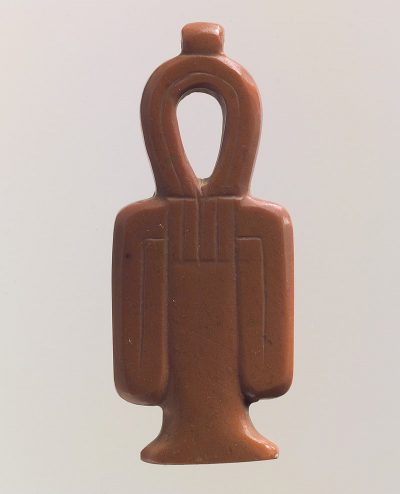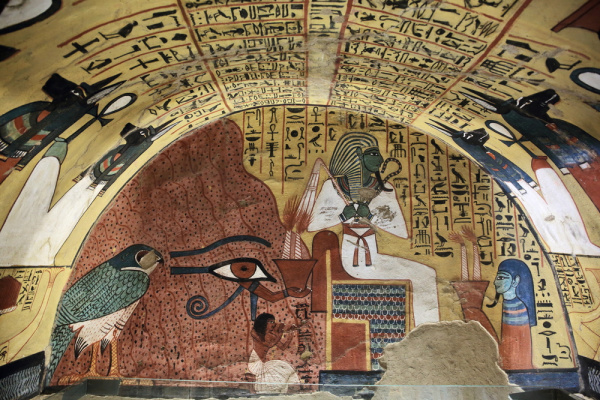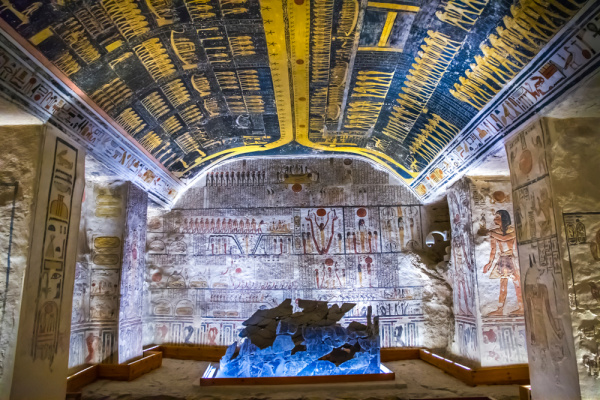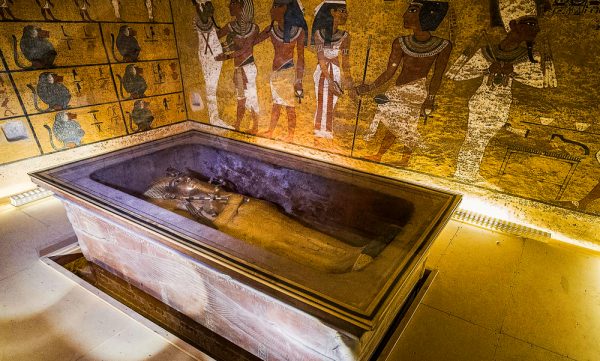Colour symbolism in Ancient Egypt
Colour symbolism in Ancient Egypt
Colour symbolism in Ancient Egypt
-
Hannah
-
Hannah

Temple of Hatshepsut
Think ‘Ancient Egyptian’, and I am sure one of the associations that springs to mind is colour – vivid colour. The iconic art that has endured for thousands of years since the reign of the pharaohs embodies a bold use of colour.
Of course, we find this use of colour striking and beautiful, and so it must have been for the Ancient Egyptians. But in fact they were not solely preoccupied with beauty in their employment of colour in art – and architecture, and even fashion. Colour was intrinsically connected to life, to existence; the word ‘iwn’ for colour also meant nature and character.
Using minerals like red and yellow ochre, blue frit, azurite, copper, malachite and charcoal, the Ancient Egyptians made bright, long-lasting colours. There were six core colours, and each had great meaning and power.
Red (desher)
In Song of the Nile, Aida meets a gypsy woman who warns her that great danger lies ahead for her. She gives Aida an amulet to wear, saying:
‘This aqiq, carnelian, will protect you and keep you from wellad el haram, the sons of evil. Always have it around your neck, for not even el jin el ahmar, the red genie, will be able to help you if you get separated from it.’
The amulet is red, for this colour symbolised protection – specifically, the blood of the mother goddess Isis. Here is a red tyet amulet; these were placed within the wrappings of mummies for protection.

Tyet amulet, Metropolitan Museum of Art
Red could also represent danger and chaos, when associated with the god Set (who killed Osiris, husband of Isis). Red was always used in depictions of Set, who was the god of chaos, violence, storms and deserts. The roots of our word ‘desert’ are found in the Egyptian word ‘dshrt’, which means ‘the red place’. The pharaoh’s double crown (the pschent) brought together the White Crown of Upper Egypt (the Hedjet) and the Red Crown of Lower Egypt (the Deshret).
Green (wadj)
Unsurprisingly, given that it is the colour of plants, green represented fertility and new life. Both Osiris and Geb (god of the earth) were painted with green skin to show their power over the fertility of the earth. ‘New life’ also meant life after death, so the colour was associated with resurrection and the afterlife, in the Field of Malachite (malachite, a green stone, was used extensively by the Ancient Egyptians).

Valley of the Kings tomb depicting the green-skinned Osiris
Green was also associated with Hathor, goddess of sex, love, marriage, beauty, fertility and death. She was often represented as a sycamore tree. Green jewellery and makeup (made from malachite) was imbued with Hathor’s love and protection.
Blue (irtyu)
This colour was deeply symbolic and signified fertility, birth, rebirth and life. Of course, it was also associated strongly with water (blue hippo statues symbolised the Nile) and with the sky (many tombs and temples featured blue ceilings).

Valley of the Kings tomb with a vivid blue ceiling
Because of the connection with the Nile, the source of life in Egypt, blue was associated with the creator god Amun – he was often depicted with blue skin. Artworks of Thoth, god of wisdom, also featured the colour blue, as did amulets of Bes, a protector god.
Yellow (khenet or kenit)
Naturally, yellow (or gold) symbolised the sun, and because the sun is eternal, the colour also represented eternity. People believed that the skin of the gods was golden, and they were often depicted in that way – and so were pharaohs after death: think of the solid gold sarcophagus of Tutankhamun. Of course, yellow and gold also drew on the power of the mighty Ra, the sun god.

Sarcophagus of Tutankhamun
White (hedj)
In keeping with the symbolism of other cultures, white represented purity and sacredness. It was actually an everyday colour – Egyptians wore white clothing (well, in fact it was often more cream in hue; rich people would be thrilled to get their hands on actual white cloth). White also featured prominently in religious life; altars in temples and objects used in rituals were often white, for example.
White was seen as the opposite of red – thus the White Crown of Upper Egypt was seen to balance the Red Crown of Lower Egypt. The word ‘hedj’ was also used to describe silver, a rare and precious commodity at the time that was used for pharaohs’ jewellery and to represent the moon.
Black (kem)
Again like many other cultures, black could mean death. It was associated with Osiris, god of the underworld, and Anubis, god of death, mummification, embalming and the afterlife. This connection with death did not give the colour a connotation of danger or evil (red conveyed this meaning). Black was a positive colour, because it did not only mean death, but also life. Egypt was Kemet – the black land. The annual inundation (flooding) of the Nile turned the soil around the river black with silt deposits, and this black soil made possible the cultivation of crops. Thus black was in fact life-giving, and the colour was used in the same way as green to convey fertility and growth.

Song of the Nile: available to buy now
Photo credits: 1) Maciek67/Shutterstock.com; 2) Metropolitan Museum of Art/Wikipedia; 3) Vladimir Melnik/Shutterstock.com; 4) Whatafoto/Shutterstock.com.